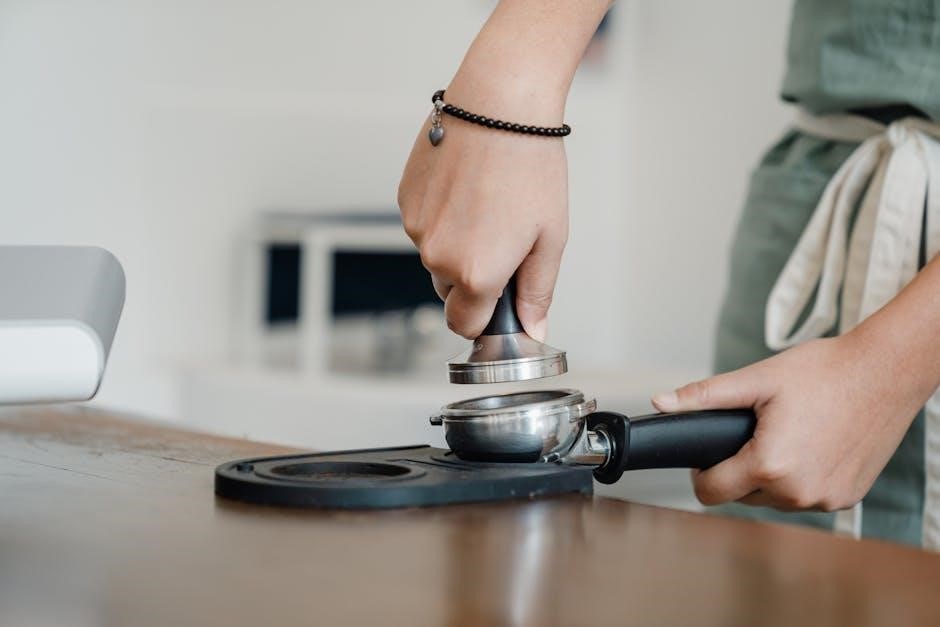The Welch Allyn Connex Spot Monitor Service Manual provides essential guidance for maintaining and servicing the device, ensuring optimal performance and patient safety in clinical settings.
1.1 Overview of the Welch Allyn Connex Spot Monitor
The Welch Allyn Connex Spot Monitor is a portable, user-friendly device designed for vital sign measurement in clinical settings. It offers precise, automated monitoring of heart rate, blood pressure, temperature, and pulse oximetry. The monitor features a compact design, touchscreen interface, and wireless connectivity options, enabling seamless integration into healthcare workflows. It is ideal for ambulatory care, providing accurate and reliable patient data. The device supports both manual and automated measurements, ensuring efficiency and patient safety. This overview highlights its key functionalities and design, serving as a foundational reference for service personnel and healthcare providers.
1.2 Purpose and Scope of the Service Manual
The service manual for the Welch Allyn Connex Spot Monitor is a comprehensive reference guide designed for trained service personnel and authorized repair centers. It outlines procedures for periodic preventive maintenance, corrective repairs, and troubleshooting to ensure optimal device performance. The manual covers field-replaceable units (FRUs) and provides detailed instructions for maintaining warranty compliance. It is intended to support healthcare professionals in delivering reliable patient monitoring while adhering to safety and regulatory standards. This document ensures the monitor operates efficiently, providing accurate vital sign measurements in clinical environments. Proper use of this manual is essential for maintaining the device’s integrity and functionality.
1.3 Key Features and Benefits of the Connex Spot Monitor
The Connex Spot Monitor offers a compact, portable design with a 3.4-inch color touchscreen, enabling quick and accurate vital sign measurements. It supports wireless connectivity, allowing seamless integration with electronic health records and other medical devices. The monitor is compatible with the Welch Allyn Service Tool (WAST), facilitating remote diagnostics and updates. Its lightweight and durable construction make it ideal for ambulatory and acute care settings. Enhanced security features ensure patient data privacy, while intuitive navigation simplifies workflow efficiency. These features collectively provide a reliable, user-friendly solution for healthcare professionals, enhancing patient care and operational effectiveness.

Safety Information
Ensure safe operation by adhering to guidelines in the manual, including electrical precautions and proper handling to prevent damage and maintain patient safety.
2.1 General Safety Precautions
To ensure safe operation, always follow guidelines in the Welch Allyn Connex Spot Monitor Service Manual. Handle the device with care to avoid damage. Protect against electrostatic discharge (ESD) by grounding yourself before servicing. Verify patient identity on the monitor after manual or automatic entry. Use only authorized accessories and follow proper cleaning procedures. Avoid exposing the monitor to extreme temperatures or humidity. Never attempt unauthorized repairs, as this may void the warranty or compromise safety. For detailed procedures, refer to the manual’s safety section.
2.2 Electrical Safety Considerations
Adhere to electrical safety guidelines when servicing the Welch Allyn Connex Spot Monitor. Ensure the device is unplugged from power sources before performing maintenance. Avoid exposing internal components to moisture or extreme temperatures, which can cause electrical hazards. Use only approved power cords and avoid overloading circuits. Ground yourself to prevent electrostatic discharge damage. Never service the monitor during thunderstorms or in areas with high humidity. Always follow the manufacturer’s instructions for safe electrical handling, as outlined in the service manual, to prevent risks of electrical shock or component failure.
2.3 Environmental and Disposal Guidelines
Follow proper environmental and disposal practices when handling the Welch Allyn Connex Spot Monitor. Dispose of batteries and electronic components responsibly, adhering to local regulations. Do not reuse single-use devices, as indicated in the manual. Ensure environmentally friendly practices by separating electrical and electronic equipment for appropriate recycling. Avoid improper disposal methods that could harm the environment. Always comply with local and international standards for medical device disposal to minimize ecological impact and ensure sustainability.

System Overview
The Welch Allyn Connex Spot Monitor is a compact, portable device designed for accurate vital sign measurement. It integrates seamlessly with healthcare systems, ensuring efficient patient monitoring.
3.1 Components of the Connex Spot Monitor
The Connex Spot Monitor includes a high-resolution 3.4-inch touchscreen display, a main processing unit, and a lightweight, portable design. It features sensors for vital signs, including blood pressure, temperature, and pulse oximetry. The monitor also includes USB ports for connectivity and an Ethernet interface for network integration. Field-replaceable units, such as the main PCA and LCD frame, simplify maintenance. The device operates on a rechargeable battery, ensuring mobility in clinical settings. These components work together to provide accurate, reliable, and efficient patient monitoring, making it a versatile tool for healthcare professionals.
3.2 Interconnectivity and Compatibility
The Connex Spot Monitor integrates seamlessly with the Welch Allyn Service Tool (WAST) via Ethernet-over-USB technology, enabling efficient updates and diagnostics. It supports dual interfaces: a generic USB serial connection and a Remote Network Driver Interface. This ensures compatibility with various Welch Allyn devices and systems. The monitor can connect to a network, allowing for remote monitoring and data sharing. Its design ensures compatibility with existing healthcare IT infrastructure, promoting streamlined workflows. The device adheres to medical standards for secure and reliable data transmission, making it a versatile solution for clinical environments.
3.3 User Interface and Navigation
The Connex Spot Monitor features a user-friendly interface with a 3.4-inch touchscreen color display, designed for intuitive navigation. The layout provides quick access to vital sign measurements, including heart rate, blood pressure, temperature, and pulse oximetry. The interface supports both manual and automatic parameter inputs, ensuring flexibility. Connectivity options include Ethernet-over-USB, enabling seamless integration with the Welch Allyn Service Tool (WAST). On-screen prompts and customizable shortcuts enhance workflow efficiency. The monitor’s interface is optimized for clinical environments, offering clear readability and straightforward menu structures to streamline patient monitoring tasks.

Installation and Setup
The Connex Spot Monitor setup involves unpacking, inventorying components, connecting peripherals, and configuring network settings. Use the Welch Allyn Service Tool (WAST) for initial configuration and connectivity.
4.1 Unpacking and Inventory
Carefully unpack the Welch Allyn Connex Spot Monitor and verify all components are included. Check for damage or tampering. The shipment typically includes the monitor unit, power cord, patient cable, and accessories. Ensure all items are accounted for to prevent operational delays. If any components are missing or damaged, contact Welch Allyn support immediately. Properly handling and verifying the inventory ensures a smooth setup process and maintains warranty validity. Always refer to the service manual for a detailed list of expected components and their condition upon delivery.
4.2 Connecting Peripheral Devices
Connect peripheral devices to the Welch Allyn Connex Spot Monitor by first powering off the monitor to avoid electrical interference. Use the appropriate USB or Ethernet ports for connecting accessories like patient cables, printers, or external sensors. Ensure all cables are securely attached to prevent loose connections. Refer to the service manual for specific port assignments and compatibility guidelines. After connecting, power on the monitor and verify device recognition through the on-screen menu. If issues arise, consult the troubleshooting section or contact authorized support for assistance. Proper connections ensure accurate data transmission and reliable monitoring functionality.
4.3 Configuring Network Settings
To configure network settings on the Welch Allyn Connex Spot Monitor, access the network configuration menu through the device’s user interface. Select either DHCP for automatic IP assignment or manually input the IP address, subnet mask, and gateway. Ensure the monitor is connected to the same network as other medical devices for seamless data integration. Use the Welch Allyn Service Tool (WAST) for advanced network configurations, such as setting up VLANs or enabling encryption. Refer to the service manual for detailed instructions and troubleshooting tips. Proper network setup is critical for secure and reliable data transmission in clinical environments.

Operation and Measurement
The Welch Allyn Connex Spot Monitor measures vital signs, including heart rate, blood pressure, and pulse oximetry, ensuring accurate and reliable patient data through advanced sensor technology.
5.1 Initializing the Monitor
Initializing the Welch Allyn Connex Spot Monitor involves powering on the device and performing a self-test to ensure all components function correctly. Connect the monitor to a power source and press the power button. The system will automatically run diagnostics, verifying sensor functionality, display accuracy, and connectivity. Use the Welch Allyn Service Tool (WAST) to configure network settings and confirm the device’s IP address. If issues arise during initialization, refer to the troubleshooting section or contact authorized service personnel. Proper initialization ensures accurate measurements and secure data transmission, critical for reliable patient monitoring and care. Always follow safety guidelines during setup.
5.2 Conducting Vital Sign Measurements
The Welch Allyn Connex Spot Monitor is designed to measure vital signs such as heart rate, blood pressure, temperature, and SpO2. Attach the appropriate sensors to the patient, ensuring proper placement for accurate readings. Use the touchscreen interface to select the measurement mode—automatic or manual. The monitor will display real-time data, with options to store results or transmit them to an electronic health record (EHR) system. Regularly verify sensor functionality and patient identification to ensure reliable data capture. Follow safety guidelines to maintain measurement accuracy and patient safety during the process. Proper sensor placement and device calibration are critical for precise readings. Always refer to the user manual for specific instructions on measuring each vital sign. This ensures consistent and accurate results, which are essential for effective patient care and monitoring.
5.3 Using the Welch Allyn Service Tool (WAST)
The Welch Allyn Service Tool (WAST) is a diagnostic and configuration software designed for the Connex Spot Monitor. It enables trained personnel to troubleshoot, update software, and monitor device performance. Connect the monitor to a PC via Ethernet or USB to access WAST. The tool provides detailed diagnostic reports, allows firmware updates, and configures network settings. WAST also enables remote monitoring and maintenance, ensuring optimal device operation. Regular use of WAST helps maintain compliance with medical standards and ensures accurate vital sign measurements. Always follow the service manual guidelines when using WAST for service procedures. Proper training is essential for effective utilization of this tool.

Maintenance and Cleaning
Regular maintenance and cleaning ensure optimal performance and longevity of the Connex Spot Monitor. Follow manual guidelines for disinfecting surfaces and replacing consumables to maintain safety standards.
6.1 Scheduled Preventive Maintenance
Regular preventive maintenance is crucial to ensure the Welch Allyn Connex Spot Monitor operates efficiently and accurately. Schedule inspections every 6 months or as specified in the manual. Check all electrical components, sensors, and connectors for wear or damage. Clean the monitor and accessories using approved disinfectants to prevent contamination. Replace consumables like batteries and cables as needed. Ensure all maintenance is performed by trained personnel using only Welch Allyn-approved parts. Unauthorized servicing may void the warranty. Refer to the manual’s appendix for detailed maintenance schedules and procedures to maintain optimal performance and patient safety.
6.2 Cleaning and Disinfecting Procedures
Proper cleaning and disinfecting of the Welch Allyn Connex Spot Monitor are essential to maintain patient safety and device functionality. Power down the monitor before cleaning. Use a soft, lint-free cloth dampened with an approved disinfectant, avoiding harsh chemicals or abrasive materials. Do not submerge any components in liquid. Clean the touchscreen gently, ensuring no moisture seeps into the display. Disinfect all surfaces, including the sensor cables and accessories, following the manufacturer’s guidelines. Regular cleaning prevents bacterial growth and ensures accurate readings. Refer to the manual for a list of recommended cleaning agents and procedures to maintain device integrity and compliance with infection control standards.
6.3 Replacing Consumables and Accessories
Regular replacement of consumables and accessories ensures the Welch Allyn Connex Spot Monitor operates effectively. Identify worn or damaged components, such as sensor cables or batteries, and replace them promptly. Use only Welch Allyn-approved parts to maintain warranty validity and device performance. Power down the monitor before replacing any consumables. Follow the manual’s step-by-step instructions for disconnection and installation. Properly dispose of used accessories, adhering to environmental guidelines. Replace consumables as recommended to prevent measurement inaccuracies and ensure patient safety. Always refer to the service manual for specific replacement procedures and compatibility information.

Troubleshooting
Troubleshooting the Welch Allyn Connex Spot Monitor involves identifying common issues, interpreting error codes, and following diagnostic procedures to restore functionality and ensure accurate measurements.
7.1 Common Issues and Solutions
The Welch Allyn Connex Spot Monitor may encounter issues such as error codes, connectivity problems, or inaccurate measurements. Common solutions include restarting the device, checking sensor connections, and ensuring proper calibration. For error codes, refer to the diagnostic messages in the manual to identify root causes. Connectivity issues can often be resolved by verifying network settings or re-establishing Ethernet connections. Additionally, cleaning the device and updating software may address performance-related problems. Always consult the troubleshooting section for detailed step-by-step solutions to restore optimal functionality and ensure accurate vital sign monitoring.
7.2 Error Codes and Diagnostic Messages
The Welch Allyn Connex Spot Monitor displays specific error codes and diagnostic messages to indicate malfunctions or operational issues. These codes, such as “E001” for connectivity problems or “E002” for sensor malfunctions, provide technicians with clear guidance for troubleshooting. The service manual includes a comprehensive list of error codes, their meanings, and recommended corrective actions. By referencing these codes, users can identify and address issues efficiently, ensuring the monitor operates correctly and provides accurate vital sign measurements. Regularly reviewing diagnostic messages helps maintain device reliability and patient safety in clinical environments.

7.3 Resetting the Device
Resetting the Welch Allyn Connex Spot Monitor can be performed to resolve operational issues or restore factory settings. A soft reset restarts the device without losing configuration data, while a hard reset erases custom settings, returning the monitor to its default state. To reset, power down the device, then press and hold the power button along with the menu key for 10 seconds. For advanced resets, use the Welch Allyn Service Tool (WAST) via USB or Ethernet connection. Always back up important data before performing a reset to prevent loss of configurations or calibration settings. Refer to the service manual for detailed instructions and precautions.

Repair and Replacement
The service manual outlines procedures for diagnosing and replacing faulty components, emphasizing the use of authorized Welch Allyn service personnel and genuine parts for safety and compliance.
8.1 Identifying Field-Replaceable Units (FRUs)
The Welch Allyn Connex Spot Monitor service manual details field-replaceable units (FRUs) such as the Main PCA and LCD Frame, each with specific service kit numbers like 105925 and 105930. These FRUs are designed to be replaced by authorized personnel, ensuring compliance with safety standards. The manual provides a comprehensive list of components, their descriptions, and associated part numbers, facilitating quick identification and replacement. Specialized tools and ESD precautions are emphasized to prevent damage during servicing. This section ensures efficient maintenance and minimizes downtime for the monitor.
8.2 Disassembly and Reassembly Procedures
The Welch Allyn Connex Spot Monitor service manual outlines detailed steps for disassembling and reassembling the device, emphasizing proper handling of components like the Main PCA and LCD Frame. Users are advised to follow a specific sequence to avoid damage, starting with removing external components and disconnecting internal cables. Specialized tools, such as a Torx screwdriver, are required for safe disassembly. During reassembly, ensure all connections are secure and components are properly aligned. The manual stresses the importance of grounding and ESD protection to prevent damage to sensitive electronics. Always refer to the manual for precise instructions to maintain device functionality and warranty compliance.
8.3 Ordering Service Kits and Parts
To ensure proper maintenance and repairs, the Welch Allyn Connex Spot Monitor requires genuine service kits and parts. Service Kit CSM (105925) includes the Main PCA and LCD Frame, while Service Kit CSM (105930) provides additional components. Ordering these kits guarantees compatibility and maintains device performance. Users should only purchase parts from authorized Welch Allyn distributors or service centers to avoid counterfeit or non-compliant items. Refer to the manual for specific part numbers and descriptions. Contact Welch Allyn support for assistance with ordering or verifying kit availability to ensure timely and accurate repairs.

Compliance and Regulations
The Welch Allyn Connex Spot Monitor complies with international medical standards and regulatory requirements, ensuring safety and reliability. Proper documentation and adherence to these guidelines are mandatory.
9.1 Regulatory Approvals and Certifications
The Welch Allyn Connex Spot Monitor is fully compliant with global medical standards and holds necessary regulatory approvals, including FDA clearance and CE marking. Rigorous testing ensures adherence to ISO standards for safety, accuracy, and reliability. These certifications confirm the device meets strict requirements for clinical use, providing assurance of quality and performance. Users can trust the monitor to operate within established guidelines, ensuring patient safety and accurate vital sign measurements. The service manual emphasizes the importance of maintaining these standards through proper maintenance and updates, as outlined in the compliance section.
9.2 Adherence to Medical Standards
The Welch Allyn Connex Spot Monitor is designed to meet rigorous medical standards, ensuring precise and reliable vital sign measurements. It complies with ISO standards for accuracy, safety, and electromagnetic compatibility, providing consistent performance in clinical environments. The monitor adheres to guidelines set by global health organizations, guaranteeing its suitability for diverse healthcare settings. Regular software updates and maintenance procedures outlined in the service manual ensure ongoing compliance with evolving medical standards, maintaining trust and efficacy in patient care. Adherence to these standards is crucial for delivering accurate and dependable results, supporting healthcare professionals in their critical roles.
9.3 Documentation and Record-Keeping
Proper documentation and record-keeping are essential for maintaining compliance and ensuring traceability of maintenance activities for the Welch Allyn Connex Spot Monitor. The service manual requires detailed records of all preventive maintenance, repairs, and software updates. Calibration records, error logs, and device performance data must be accurately documented and securely stored. These records are critical for audits, warranty claims, and ensuring adherence to regulatory requirements. The manual emphasizes the importance of maintaining both physical and digital copies of all service-related documentation to ensure data integrity and accessibility for future reference. Accurate record-keeping supports compliance with medical standards and device performance tracking.
This manual guides users through maintaining and servicing the Welch Allyn Connex Spot Monitor, ensuring optimal performance, compliance, and patient safety. Regular maintenance is crucial for device longevity and accuracy. For further assistance, contact Welch Allyn support.
10.1 Summary of Key Service Procedures
The Welch Allyn Connex Spot Monitor service manual outlines critical procedures for maintenance, troubleshooting, and repair. Regular calibration, software updates, and power management ensure accuracy and reliability. Users must replace consumables like SpO2 sensors and batteries as needed. Adherence to safety guidelines and environmental regulations is essential. Proper disassembly and reassembly techniques, along with diagnostic tools, help resolve common issues. Following these procedures ensures optimal performance, extends device longevity, and maintains patient safety. Compliance with manufacturer recommendations is vital for warranty validity and operational integrity.
10.2 Importance of Proper Maintenance
Proper maintenance of the Welch Allyn Connex Spot Monitor is crucial for ensuring accuracy, reliability, and patient safety. Regular cleaning, software updates, and battery checks prevent malfunctions and extend device longevity. Neglecting maintenance can lead to measurement errors or system downtime, compromising patient care. Adhering to scheduled preventive maintenance and environmental guidelines ensures compliance with medical standards. Proper handling and storage also safeguard the device from damage. Following the service manual’s guidelines is essential for maintaining warranty validity and ensuring optimal performance in clinical settings. Consistent upkeep guarantees precise vital sign monitoring, which is critical for effective patient management.
10.3 Contact Information for Support
For any inquiries, technical assistance, or repair services, contact Welch Allyn authorized service centers. Reach them at 1-800-535-6660 or visit their official website at www.welchallyn.com/support. Trained professionals are available to address issues, provide troubleshooting, and perform warranty repairs. Ensure to use only genuine parts and authorized service to maintain device performance and warranty validity. Unauthorized repairs may void the warranty and compromise patient safety. Contacting official support ensures compliance with medical standards and guarantees reliable service for the Connex Spot Monitor.